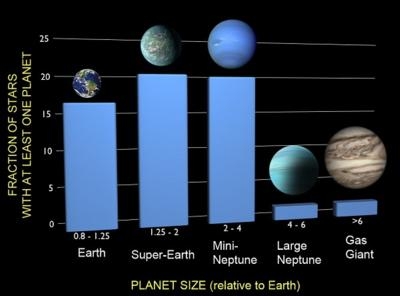Mon, Jan 14, 2013
Milky Way Galaxy May Contain 17 Billion Planets Of Similar Size
The quest to determine if planets like Earth are rare or common is taking another stride forward. Using NASA's Kepler spacecraft, managed by NASA Ames Research Center, astronomers are beginning to find Earth-sized planets orbiting distant stars. A new analysis of Kepler data shows that about 17 percent of stars have an Earth-sized planet in an orbit closer than Mercury. Since the Milky Way has about 100 billion stars, there are at least 17 billion Earth-sized worlds out there.

Francois Fressin, of the Harvard-Smithsonian Center for Astrophysics (CfA), presented the analysis today in a press conference at a meeting of the American Astronomical Society in Long Beach, CA. A paper detailing the research has been accepted for publication in The Astrophysical Journal. The research team found that 50 percent of all stars have a planet of Earth-size or larger in a close orbit. By adding larger planets detected in wider orbits up to the orbital distance of the Earth, this number increases to 70 percent.
Extrapolating from Kepler's currently ongoing observations and results from other detection techniques, scientists have determined that nearly all sun-like stars have planets. Planets closer to their stars are easier to find because they transit more frequently. As more data are gathered, planets in larger orbits will be detected. In particular, Kepler's extended mission will enable the detection of Earth-sized planets at greater distances, including Earth-like orbits in the "habitable zone," the region in a planetary system where liquid water might exist on the surface of an orbiting planet.
Kepler is the first NASA mission capable of finding Earth-size planets orbiting in or near the habitable zone of the host star. NASA's Ames Research Center, Moffett Field, CA, is the home organization of the science principal investigator, and is responsible for the ground system development, mission operations, and science data analysis.
(Image provided by NASA)
More News
He Attempted To Restart The Engine Three Times. On The Third Restart Attempt, He Noticed That Flames Were Coming Out From The Right Wing Near The Fuel Cap Analysis: The pilot repor>[...]
Make Sure You NEVER Miss A New Story From Aero-News Network Do you ever feel like you never see posts from a certain person or page on Facebook or Instagram? Here’s how you c>[...]
From 2009 (YouTube Edition): Leading Air Show Performers Give Their Best Advice for Newcomers On December 6th through December 9th, the Paris Las Vegas Hotel hosted over 1,500 air >[...]
Aero Linx: NASA ASRS ASRS captures confidential reports, analyzes the resulting aviation safety data, and disseminates vital information to the aviation community. The ASRS is an i>[...]
“For our inaugural Pylon Racing Seminar in Roswell, we were thrilled to certify 60 pilots across our six closed-course pylon race classes. Not only did this year’s PRS >[...]
 NTSB Final Report: Rutan Long-EZ
NTSB Final Report: Rutan Long-EZ ANN FAQ: Turn On Post Notifications
ANN FAQ: Turn On Post Notifications Classic Aero-TV: ICAS Perspectives - Advice for New Air Show Performers
Classic Aero-TV: ICAS Perspectives - Advice for New Air Show Performers ANN's Daily Aero-Linx (06.28.25)
ANN's Daily Aero-Linx (06.28.25) Aero-News: Quote of the Day (06.28.25)
Aero-News: Quote of the Day (06.28.25)



